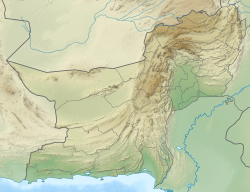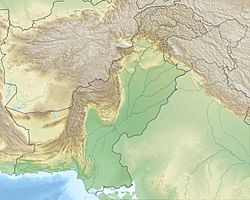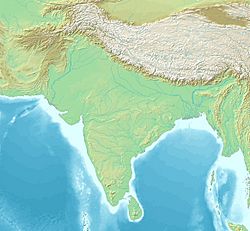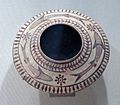Mehrgarh facts for kids
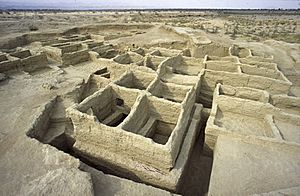
Ruins of houses at Mehrgarh, Balochistan
|
|
| Alternative name | Mehrgahr, Merhgarh, Merhgahr |
|---|---|
| Location | Balochistan, Pakistan |
| Region | South Asia |
| Coordinates | 29°23′N 67°37′E / 29.383°N 67.617°E |
| History | |
| Founded | c. 7000 BCE |
| Abandoned | c. 2600 BCE |
| Periods | Neolithic |
| Site notes | |
| Excavation dates | 1974–1986, 1997–2000 |
| Archaeologists | Jean-François Jarrige, Catherine Jarrige |
| Followed by: Early Harappan period | |
Mehrgarh is an ancient archaeological site in Pakistan. It dates back to the Neolithic period, from about 7000 BCE to 2500 BCE. This means it was a very old settlement, even before the famous Indus Valley Civilisation.
Mehrgarh is located on the Kacchi Plain in Balochistan. It's near the Bolan Pass, which is an important mountain pass. The site is west of the Indus River.
French archaeologists Jean-François Jarrige and his wife, Catherine Jarrige, discovered Mehrgarh in 1974. They led many excavations there until 2000. Over 32,000 artifacts have been found at the site. The earliest part of Mehrgarh was a small farming village. It existed between 7000 BCE and 5500 BCE.
Contents
History of Mehrgarh
Mehrgarh is the oldest known place in South Asia where people started farming and raising animals. This was a huge step for humanity, often called the Neolithic Revolution. People began to grow crops like wheat and barley. They also herded sheep, goats, and cattle.
Some experts believe that the farming culture at Mehrgarh was influenced by ideas from the Near East. They see similarities in crops, farming methods, and pottery. Other experts, like Jean-Francois Jarrige, think Mehrgarh developed on its own. They believe it had its own unique beginnings.
Archaeologists have found evidence of a "cultural connection" between Mehrgarh and places in eastern Mesopotamia. This suggests that ideas and people moved between these regions. However, Mehrgarh also shows many original features. This means it was not just a copy of other cultures.
Studies of ancient teeth and DNA suggest that the people of Mehrgarh changed over time. While the culture continued, the population might have shifted. This means new groups of people likely moved into the area.
Periods of Life at Mehrgarh
Archaeologists divide the history of Mehrgarh into eight main periods. Each period shows different ways of life and new technologies.
Mehrgarh Period I (7000 BCE–5500 BCE)
This was the earliest time at Mehrgarh. People were Neolithic, meaning they used stone tools. They did not use pottery yet. These early settlers were semi-nomadic farmers. They grew wheat and barley. They also raised sheep, goats, and cattle.
People lived in houses made of unbaked mud-bricks. Many houses had four rooms inside. Archaeologists found many burials from this period. Some burials had special items like baskets, stone tools, and beads. Sometimes, animals were sacrificed and buried with people. Ornaments made from seashells, limestone, and turquoise were also found. These items show that people traded with distant places. For example, seashells came from far-off seashores. Lapis lazuli came from as far as Badakhshan in present-day Afghanistan.
In 2001, archaeologists made an amazing discovery. They found that people in Mehrgarh knew about early dentistry. In 2006, the journal Nature reported the oldest evidence of drilling human teeth. This was found in a graveyard at Mehrgarh. It shows that people were practicing a form of dentistry 7,500 to 9,000 years ago!
Mehrgarh Period II (5500 BCE–4800 BCE) and Period III (4800 BCE–3500 BCE)
During these periods, people started using pottery. This is why it's called the ceramic Neolithic and later the Chalcolithic period. They also used more advanced techniques for making things.
They made shiny faience beads. Terracotta figurines became more detailed. Female figurines were painted and had different hairstyles. Burials in Period II sometimes had bodies covered in red ochre. The number of items buried with people decreased over time.
People started making the first button seals from terracotta and bone. These seals had geometric patterns. New technologies appeared, like stone and copper drills. They also used special ovens called kilns for pottery. Trade continued, as shown by lapis lazuli beads from Badakhshan.
Mehrgarh Periods IV, V and VI (3500 BCE–3000 BCE)
These periods show continued development. Period IV was from 3500 to 3250 BCE. Period V was from 3250 to 3000 BCE. Period VI was around 3000 BCE.
Mehrgarh Period VII (2600 BCE–2000 BCE)
Around 2600 BCE, people started to leave Mehrgarh. They likely moved to a larger, fortified town called Nausharo, about five miles away. This happened when the Indus Valley Civilisation was developing. Historian Michael Wood suggests this move happened around 2500 BCE.
Mehrgarh Period VIII
The last period of Mehrgarh is found at the Sibri cemetery. This site is about 8 kilometers from Mehrgarh.
Daily Life and Technology
Early people in Mehrgarh lived in mud brick houses. They stored their grain in special buildings called granaries. They made tools from local copper. They even lined their large baskets with bitumen to make them waterproof.
They grew different types of barley and wheat. They also cultivated jujubes and dates. They continued to herd sheep, goats, and cattle. Later, from 5500 BCE to 2600 BCE, people focused on crafts. These included shaping flint stones, tanning leather, making beads, and working with metal. Mehrgarh is thought to be the earliest place in South Asia where agriculture began.
An amazing discovery at Mehrgarh is a 6,000-year-old copper amulet. It was made using the lost-wax technique. This is a very old and clever way to cast metal.
Artifacts Found
Many interesting objects have been found at Mehrgarh. They tell us a lot about the people who lived there.
Human Figurines
The oldest ceramic figurines in South Asia were found at Mehrgarh. These small statues were made even before people started using pottery. The earliest ones are simple. But over time, they became more detailed. By 4000 BCE, they showed unique hairstyles.
Most of the figurines from early periods were female. Male figurines appeared later, in Period VII. Many female figurines hold babies. Some experts think these might represent a "mother goddess." Others prefer to call them "female figurines with religious meaning."
Pottery
Evidence of pottery starts in Period II. In Period III, pottery became much more common. The potter's wheel was introduced, making pottery production easier. Designs became more complex, often showing animal patterns.
From Period VI, people used pipal leaf designs. They also used advanced firing techniques for pottery. An area for pottery making was found at the site. However, in Period VIII, the quality of pottery seemed to decline. This might be because people became more interested in bronze and copper vessels.
Burials
Archaeologists found two main types of burials at Mehrgarh. Some were individual burials, where one person was buried in a small mud-brick space. Others were collective burials. These had thin mud-brick walls and contained the skeletons of up to six people. Bodies were placed in a bent position, facing east to west. Bones of children were sometimes found in large jars or urns.
Metallurgy
Early metal items, mostly made of copper, have been found from as early as Period IIB.
See also
 In Spanish: Mejergar para niños
In Spanish: Mejergar para niños
- Indus Valley Civilisation and the list of Indus Valley Civilisation sites
- List of inventions and discoveries of the Indus Valley Civilisation
- Bolan Pass
- Nausharo
- Quetta
Images for kids


